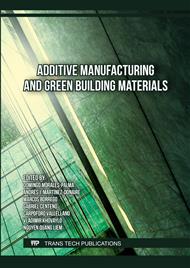[1]
W. E. Frazier, Metal additive manufacturing: A review, Journal of Materials Engineering and Performance, vol. 23, no. 6. Springer New York LLC, p.1917–1928, Apr. 08, 2014.
DOI: 10.1007/s11665-014-0958-z
Google Scholar
[2]
A. Gisario, M. Kazarian, F. Martina, and M. Mehrpouya, Metal additive manufacturing in the commercial aviation industry: A review, J Manuf Syst, vol. 53, p.124–149, Oct. 2019.
DOI: 10.1016/j.jmsy.2019.08.005
Google Scholar
[3]
D. S. Thomas and S. W. Gilbert, Costs and Cost Effectiveness of Additive Manufacturing, Dec. 2014.
DOI: 10.6028/NIST.SP.1176
Google Scholar
[4]
G. Costabile, M. Fera, F. Fruggiero, A. Lambiase, and D. Pham, Cost models of additive manufacturing: A literature review, International Journal of Industrial Engineering Computations, vol. 8, no. 2, p.263–282, Apr. 2016.
DOI: 10.5267/J.IJIEC.2016.9.001
Google Scholar
[5]
C. Leyens and M. Peters, Titanium and Titanium alloys - Fundamentals and Applications. 2003.
DOI: 10.1002/3527602119
Google Scholar
[6]
J. Donachie and J. M, Titanium – A Technical Guide, ASM International 2nd edition, vol. 55, no. 11, p.1023–1026, Dec. 2000.
DOI: 10.31399/ASM.TB.TTG2.9781627082693
Google Scholar
[7]
B. Dutta and F. H. Froes, Additive Manufacturing of Titanium Alloys: State of the Art, Challenges and Opportunities. CG, 2016.
DOI: 10.1016/C2015-0-02470-4
Google Scholar
[8]
S. E. Brika, M. Letenneur, C. A. Dion, and V. Brailovski, Influence of particle morphology and size distribution on the powder flowability and laser powder bed fusion manufacturability of Ti-6Al-4V alloy, Addit Manuf, vol. 31, p.100929, Jan. 2020.
DOI: 10.1016/J.ADDMA.2019.100929
Google Scholar
[9]
P. A. Lykov, L. V. Radionova, and A. O. Shultc, Influence of Powder Layer Thickness on Microstructure of Selective Laser Melted TiAl6V4, Solid State Phenomena, vol. 299, p.524–529, 2020.
DOI: 10.4028/WWW.SCIENTIFIC.NET/SSP.299.524
Google Scholar
[10]
X. Shi, C. Yan, W. Feng, Y. Zhang, and Z. Leng, Effect of high layer thickness on surface quality and defect behavior of Ti-6Al-4V fabricated by selective laser melting, Opt Laser Technol, vol. 132, p.106471, Dec. 2020.
DOI: 10.1016/J.OPTLASTEC.2020.106471
Google Scholar
[11]
C. de Formanoir et al., Increasing the productivity of laser powder bed fusion: Influence of the hull-bulk strategy on part quality, microstructure and mechanical performance of Ti-6Al-4V, Addit Manuf, vol. 33, p.101129, May 2020.
DOI: 10.1016/J.ADDMA.2020.101129
Google Scholar
[12]
ASTM Subcommittee B09.02, ASTM B213-20. Standard Test Methods for Flow Rate of Metal Powders Using the Hall Flowmeter Funnel.
DOI: 10.1520/B0213-20
Google Scholar
[13]
ASTM Subcommittee E28.04, ASTM E8/E8M-22. Standard Test Methods for Tension Testing of Metallic Materials.
DOI: 10.1520/E0008_E0008M-22
Google Scholar
[14]
ISO/TC 164/SC 1, ISO 6892-1:2019, Metallic materials — Tensile testing — Part 1: Method of test at room temperature. [Online]. Available: https://www.iso.org/obp/ui/#iso:std:iso: 6892:-1:ed-3:v1:en
DOI: 10.5555/demo_1.1
Google Scholar
[15]
AMSH81200D: Heat Treatment of Titanium and Titanium Alloys - SAE International. https://www.sae.org/standards/content/amsh81200d/ (accessed Apr. 11, 2023).
Google Scholar
[16]
Developed by Subcommittee: F42.05, ASTM F3001-14 (2021). Standard Specification for Additive Manufacturing Titanium-6 Aluminum-4 Vanadium ELI (Extra Low Interstitial) with Powder Bed Fusion. https://www.astm.org/f3001-14r21.html (accessed Feb. 28, 2023).
DOI: 10.1520/f3001-14
Google Scholar
[17]
C. Qiu, C. Panwisawas, M. Ward, H. C. Basoalto, J. W. Brooks, and M. M. Attallah, On the role of melt flow into the surface structure and porosity development during selective laser melting, Acta Mater, vol. 96, p.72–79, Sep. 2015.
DOI: 10.1016/J.ACTAMAT.2015.06.004
Google Scholar



